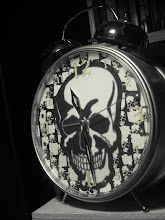 I managed to dismantle the bicycle down to the frameset. The stem was (and still is) dead stuck inside the steerer, and I didn't want to resolve to heat; inspection of cups and bearings showed them being in excellent condition, so I removed old grease with an oil-remover soaked toothbrush and re-greased the bearings. I know it's cheating, but the idea of this project is to keep as many original parts as possible and not to spend a fortune. Plus the fork has pretty cool lugs, and is in too good condition to replace just yet.
I managed to dismantle the bicycle down to the frameset. The stem was (and still is) dead stuck inside the steerer, and I didn't want to resolve to heat; inspection of cups and bearings showed them being in excellent condition, so I removed old grease with an oil-remover soaked toothbrush and re-greased the bearings. I know it's cheating, but the idea of this project is to keep as many original parts as possible and not to spend a fortune. Plus the fork has pretty cool lugs, and is in too good condition to replace just yet. Taking the bike apart showed that it has not been ridden much in the last... mmm... lets say 5 years. The rust was mostly on the top left side, almost none on the frame (95% on the chrome parts). It looked like there was constant source of dampness on one side, while the other remained relatively protected. The frame is not scratched either; all cups and bearings are in perfect condition.
Taking the bike apart showed that it has not been ridden much in the last... mmm... lets say 5 years. The rust was mostly on the top left side, almost none on the frame (95% on the chrome parts). It looked like there was constant source of dampness on one side, while the other remained relatively protected. The frame is not scratched either; all cups and bearings are in perfect condition.
Moreover there is epic spiderweb inside the fenders and brake handles: I dropped a washer in it by accident, and it got stuck there!
The lady is taking her bath; the frame is metallic brown, so it
 camouflages rust perfectly (good to hide a half-ass derusting job, bad because it makes the rust easy to miss: the cause of the half-ass job!). Washing it removed about half of the stuff that looked like rust at first, but turned out to be dirt. Also showed the almost new condition of the frame. Serious rust was only inside the fenders.
camouflages rust perfectly (good to hide a half-ass derusting job, bad because it makes the rust easy to miss: the cause of the half-ass job!). Washing it removed about half of the stuff that looked like rust at first, but turned out to be dirt. Also showed the almost new condition of the frame. Serious rust was only inside the fenders.The wheels are entirely different story. Steel rims ("heavy as a prerevolutionary iron"), gathered some rust, but still look pretty cool, and make me want to reuse them to keep the original parts on. Hubs are in average condition. Spokes, on the other hand, loosened and rusted, so at least the back wheel is to rebuild.
 Now, the Great Wheel Dilemma arises: to use the heavy and rust prone steel rims, or to upgrade to aluminum. If to upgrade, then it would make sense to upgrade the hubs as well. The second part of the dilemma is to whether keep it as a 5-speed (reuse same rear hub and/or sprockets) or to put a coaster brake. Coaster brake solves the potential problem with rusty brake levers and handles, and derailer. This also makes the bike lighter, and can compensate for the use of steel rims, and reduces the problems with wet weather braking.
Now, the Great Wheel Dilemma arises: to use the heavy and rust prone steel rims, or to upgrade to aluminum. If to upgrade, then it would make sense to upgrade the hubs as well. The second part of the dilemma is to whether keep it as a 5-speed (reuse same rear hub and/or sprockets) or to put a coaster brake. Coaster brake solves the potential problem with rusty brake levers and handles, and derailer. This also makes the bike lighter, and can compensate for the use of steel rims, and reduces the problems with wet weather braking.












